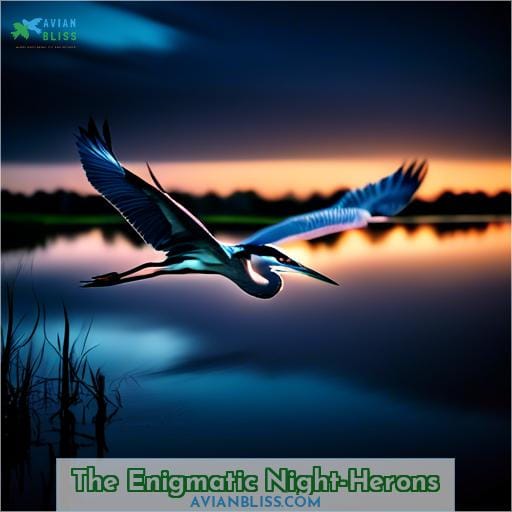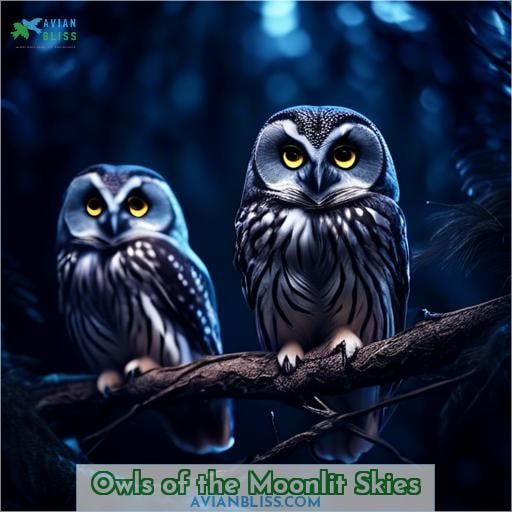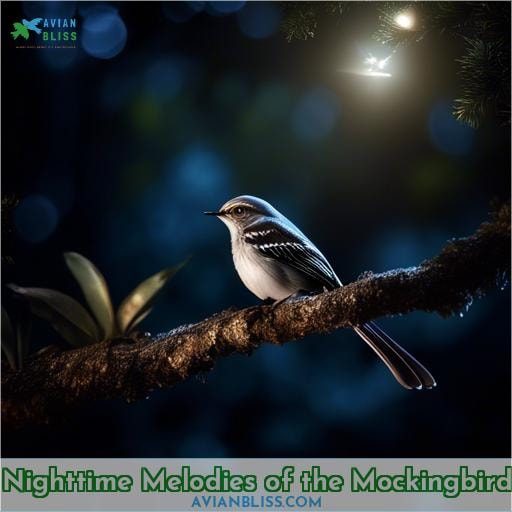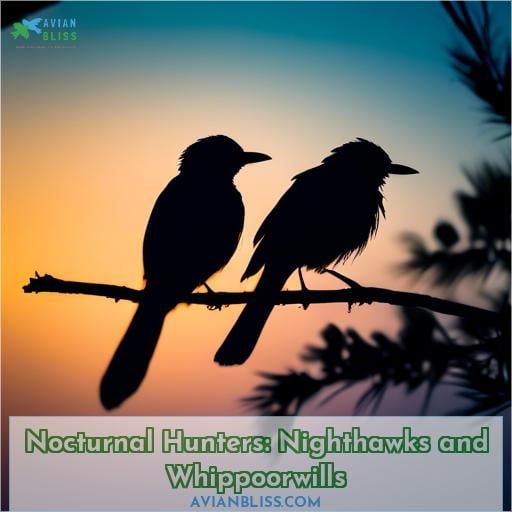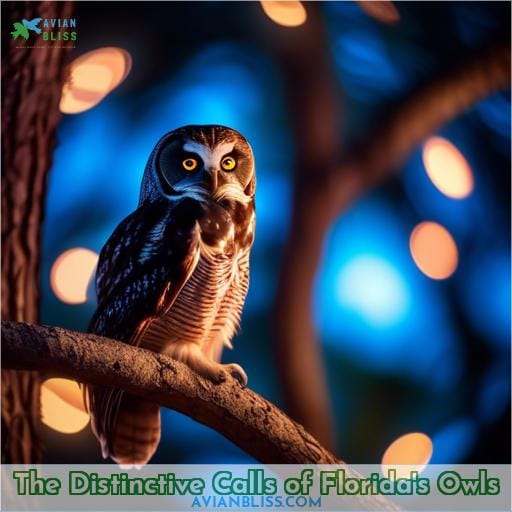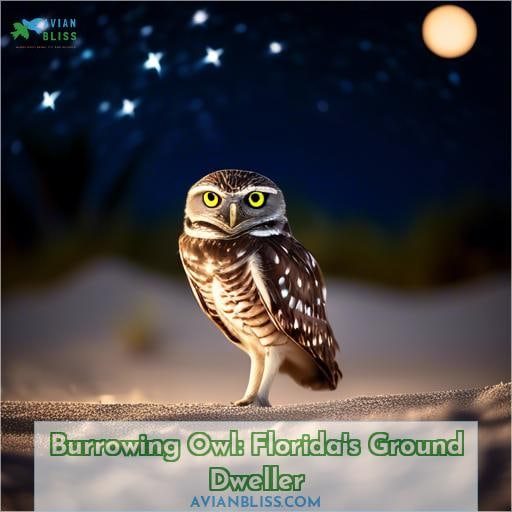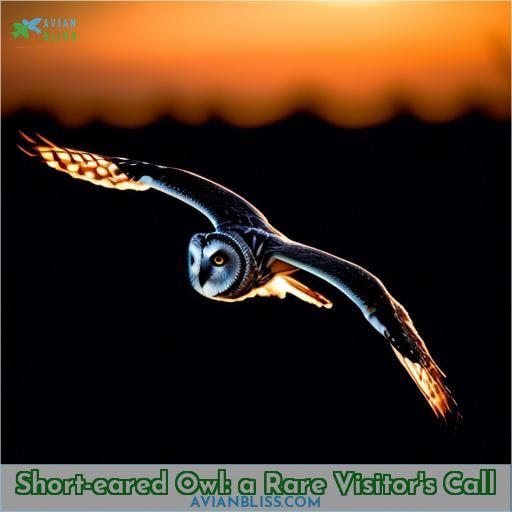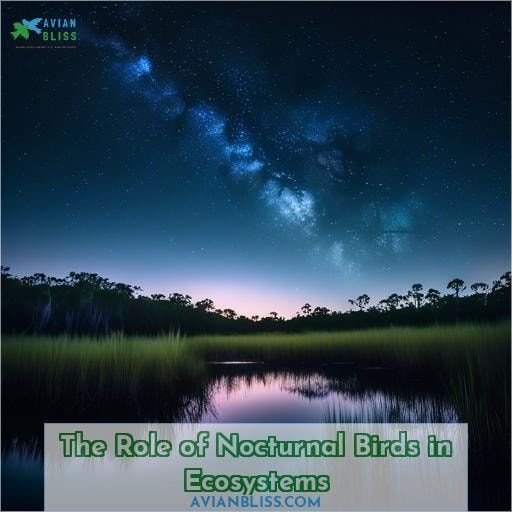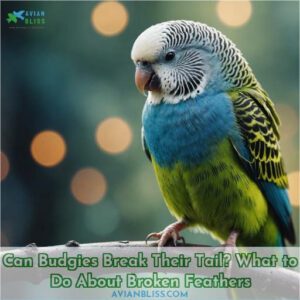This site is supported by our readers. We may earn a commission, at no cost to you, if you purchase through links.
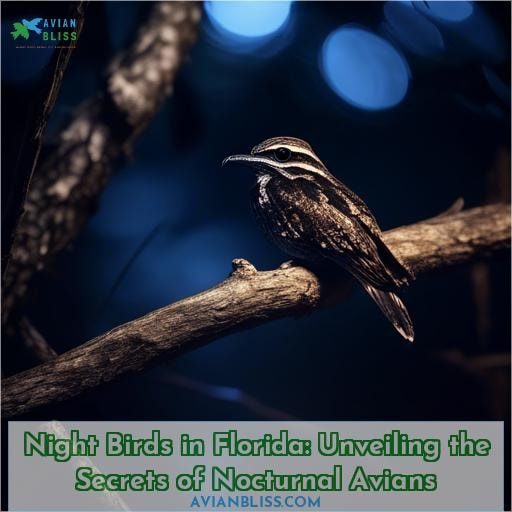 Imagine Florida’s night sky as a bustling airport, where night birds are the unsung pilots navigating through the dark.
Imagine Florida’s night sky as a bustling airport, where night birds are the unsung pilots navigating through the dark.
You’re about to embark on a journey into the secretive lives of these nocturnal avians. From the haunting calls of owls to the silent swoops of nighthawks, we’ll explore the diverse cast that makes the moonlit skies their stage.
This article isn’t just a guide; it’s an invitation to uncover the mysteries of night birds in Florida, where every chirp and wingbeat tells a story of survival, adaptation, and beauty.
Table Of Contents
- Key Takeaways
- Exploring Florida’s Nocturnal Birds
- The Enigmatic Night-Herons
- Owls of the Moonlit Skies
- Nighttime Melodies of the Mockingbird
- The Secretive Life of the Yellow-breasted Chat
- Nocturnal Hunters: Nighthawks and Whippoorwills
- The Distinctive Calls of Florida’s Owls
- Burrowing Owl: Florida’s Ground Dweller
- Short-eared Owl: a Rare Visitor’s Call
- The Role of Nocturnal Birds in Ecosystems
- Frequently Asked Questions (FAQs)
- Conclusion
Key Takeaways
- Nocturnal birds play a vital role in Florida’s ecosystems by providing natural pest control, aiding in pollination, and facilitating seed dispersal.
- Florida is home to a variety of owl species, each with unique hunting adaptations and behaviors, such as the silent flight of barn owls and the ground-dwelling habits of burrowing owls.
- Songbirds that are active at night, including northern mockingbirds and nighthawks, contribute to the nocturnal soundscape and have specialized feeding habits that benefit the environment.
- These birds face significant conservation challenges, such as habitat loss and light pollution, which can disrupt their nocturnal activities and migration patterns, underscoring the need for conservation efforts to ensure their survival and the ecological balance.
Exploring Florida’s Nocturnal Birds
As you venture into the twilight of Florida’s landscapes, you’re not just a spectator—you’re part of a living tapestry where night birds play a pivotal role. Imagine the herons, stealthy and poised, as they scour the waters for their next meal.
Their presence is a testament to the rich banquet that Florida’s ecosystems offer.
Now, shift your gaze to the treetops where owls, the enigmatic guardians of the night, survey their domains. Their haunting calls echo through the air, a lullaby for the creatures of the dark. These calls aren’t just sounds; they’re the threads that weave the fabric of Florida’s nocturnal world together.
In this hidden nocturne, every rustle and hoot is a note in an ongoing symphony. As you immerse yourself in the habitats of these night birds, you’re not just observing—you’re connecting with a part of Florida wildlife that thrives under the cover of darkness.
So, listen closely, for the night birds in Florida have stories to tell, and their whispers carry the secrets of the night.
The Enigmatic Night-Herons
You’ll find the Black-crowned Night-Heron’s foraging habits fascinating, as they skillfully navigate the twilight to find their next meal. The Yellow-crowned Night-Heron, with its striking coastal presence, showcases the intricate balance between nature’s beauty and the struggle for survival.
Black-crowned Night-Heron Foraging Habits
As we delve deeper into the nocturnal avians of Florida, let’s focus on the black-crowned night-heron’s unique foraging habits.
- A preference for aquatic environments, where they skillfully hunt.
- An eclectic diet, feasting on a variety of preferred prey from fish to frogs.
- Adaptability in coastal ecology, thriving in both fresh and saltwater habitats.
- The art of silence, their stealthy movements barely disturbing the water’s surface.
Their presence adds a mysterious layer to Florida’s nature, echoing bird calls that resonate with our innate curiosity.
Yellow-crowned Night-Heron’s Coastal Presence
As you wander Florida’s coastal wetlands, keep an eye out for the elusive Yellow-crowned Night-Heron.
Its foraging habits are a dance with the tides, plucking fish, frogs, and crustaceans from the shallows.
Spotting a Yellow-crowned Night-Heron is like finding a hidden gem; a reminder that nature’s marvels don’t clock out at sunset.
Owls of the Moonlit Skies
You’ll often hear the haunting calls of the Barred Owl piercing the stillness of Florida’s night. The Eastern Screech-Owl, with its varied diet, thrives in the moonlit ecosystems of the state.
Calls of the Barred Owl
Imagine you’re tucked in your cozy bed, and the night air carries the unique who cooks for you, who cooks for you-all call of the barred owl.
- The barred owl’s vocalizations serve as love songs during mating season.
- Their calls mark the boundaries of their woodland realms, a clear message to rivals.
- Habitat preference is whispered through these sounds, revealing their love for dense forests.
- Each call connects us to the mysterious world of Florida’s night birds, making the night feel a bit safer and more magical.
Eastern Screech-Owl’s Varied Diet
Just as the Barred Owl’s hoots echo through the night, the Eastern Screech-Owl’s varied diet reflects its adaptability in the wild. These pint-sized predators feast on a smorgasbord of nocturnal critters, from jittery insects to unsuspecting small mammals.
Their dining habits are a testament to their role as stealthy overseers of the ecosystem’s balance.
| Prey Type | Examples |
|---|---|
| Insects | Moths, Beetles |
| Small Mammals | Mice, Shrews |
| Amphibians | Frogs, Toads |
| Other Creatures | Worms, Crayfish |
In the quiet of the night, the Eastern Screech-Owl thrives, a silent guardian in its woodland home.
Nighttime Melodies of the Mockingbird
As you wander through Florida’s moonlit landscapes, you’re serenaded by the enchanting melodies of the Northern Mockingbird. These virtuosos of the night sky have a knack for mimicking the tunes of their fellow avian friends, creating a symphony that resonates with the soul.
Imagine, under the cloak of darkness, these feathered performers take center stage, their songs weaving through the air, a testament to their remarkable adaptability and survival skills.
The Northern Mockingbird’s repertoire is vast, a reflection of their keen observation and ability to learn from the environment. This talent not only helps them communicate but also plays a crucial role in warding off nocturnal predators.
Their habitat preferences lean towards open areas where they can easily spot food sources, from insects to berries, ensuring their survival in Florida’s diverse ecosystems.
Among the chorus of night singers, you might also hear the distinct calls of the Nightjar and the Yellow-breasted Chat, each adding their unique notes to the nocturnal concert. These birds that sing at night in Florida offer a glimpse into the intricate dance of nature, where every sound tells a story of adaptation, survival, and the sheer joy of existence.
The Secretive Life of the Yellow-breasted Chat
As the moonlit serenade of the mockingbird fades into the backdrop of the night, you might find yourself drawn to the more reclusive Yellow-breasted Chat. This elusive bird, a master of hide and seek, thrives in the dense underbrush of Florida’s wilder corners.
- Imagine the rustle of leaves as a Yellow-breasted Chat darts through the thicket, its vibrant yellow throat a flash in the dim light.
- Listen for its distinctive call, a quirky mix of whistles and cackles that punctuates the stillness of the night.
- Picture the bird meticulously weaving its nest, a private haven amidst tangled vines and shrubs.
- Reflect on the importance of ongoing conservation efforts to ensure these night birds of Florida continue to grace the twilight with their presence.
In your quest for connection with nature’s nocturnal symphony, the Yellow-breasted Chat’s secretive life offers a glimpse into the complex tapestry of habitat preferences, nesting behavior, and diet composition that sustains these enigmatic creatures.
Let the sounds of night birds in Florida guide you to a deeper appreciation of the world that awakens as the sun sets.
Nocturnal Hunters: Nighthawks and Whippoorwills
You’ll find the Common Nighthawk soaring through open habitats, skillfully feeding in the twilight. Meanwhile, the Eastern Whip-poor-will prefers the ground, roosting silently among the forest’s leaf litter.
Common Nighthawk’s Open Habitat Feeding
Imagine you’re strolling through an open habitat at dusk, and suddenly, the sky comes alive with the common nighthawk’s aerial display.
These night-time acrobats dive and weave with precision, snatching up their chosen prey in a dance that’s both thrilling and vital for their survival.
Their nesting behavior, often on the ground in these open spaces, adds a layer of intrigue.
As they prepare for their seasonal migration, these birds remind us of the interconnectedness of life.
Their presence, alongside the eastern whip-poor-will and the burrowing owl, enriches Florida’s nocturnal tapestry.
Eastern Whip-poor-will’s Ground Roosting
Imagine you’re strolling through Florida’s twilight, and you stumble upon the eastern whip-poor-will, a master of disguise with its ground roosting habits. This bird’s cryptic behavior is a marvel of nocturnal adaptations, blending seamlessly into its habitat.
Unlike its sky-bound cousins, the great horned owl and the barn owl, or the water-loving black-crowned and yellow-crowned night herons and green heron, the whip-poor-will opts for the earthy bed, a testament to nature’s diverse playbook.
It’s a hidden gem in the avian world, quietly asserting its presence under the cloak of night.
The Distinctive Calls of Florida’s Owls
You’ll recognize the Great Horned Owl by its commanding hoots that echo through the night.
Great Horned Owl’s Vocal Presence
Imagine you’re strolling through Florida’s moonlit forests when suddenly, the deep, resonant hoots of the Great Horned Owl pierce the night. This isn’t just any sound; it’s a declaration of vocal territory, a key aspect of their hunting strategies and nighttime communication.
- Vocal Territory: Their calls map out their domain.
- Nighttime Communication: A language in the dark.
- Hunting Strategies: Silence before the strike.
- Prey Selection: From the American Bittern to smaller mammals.
- Relative Size & Color Pattern: A majestic silhouette against the night sky.
These owls, among the diverse types of night birds in Florida, remind us of nature’s intricate balance and the thrill of the unseen.
Barn Owl’s Silent Flight
After the deep, resonant calls of the Great Horned Owl, you’ll find the Barn Owl’s silent flight equally captivating. Unlike its vocal cousins, the Barn Owl glides ghost-like, a master of stealth due to its unique feather structure that muffles sound.
This silent approach is key to its nocturnal feeding habits, allowing it to swoop on unsuspecting prey. Yet, these magnificent birds face conservation concerns, with habitat loss threatening their silent nights.
| Feature | Detail |
|---|---|
| Silent Flight | Muffled feather edges |
| Feeding Habits | Nocturnal hunter |
| Conservation | Habitat preservation |
Their silent wings are a whisper in the night, a testament to nature’s nocturnal adaptations.
Burrowing Owl: Florida’s Ground Dweller
As you’ve journeyed through the nocturnal symphony of Florida’s owls, you’ve encountered the deep hoots of the Great Horned and the ghostly whispers of the Barn Owl. Now, let’s turn your attention to the ground, where the Burrowing Owl makes its home.
Unlike its tree-perching cousins, this pint-sized predator has carved out a life in the sandy soils, turning abandoned burrows into cozy nests.
You’ll find the Burrowing Owl is a bit of an oddball, active during the day despite its nocturnal kin. Its diurnal activity is a sight to behold, as it stands guard at the burrow’s entrance or sallies forth in search of a meal.
The prey diversity on its menu is impressive, ranging from insects to small rodents, showcasing its adaptability.
These owls are a quirky bunch, with their long legs seemingly made for a life on the ground. They’ve turned the traditional owl lifestyle on its head, embracing the sunlight while maintaining their mastery of the moonlit hunt.
So next time you’re out exploring, keep an eye on the ground—you might just spot one of these charming ground dwellers.
Short-eared Owl: a Rare Visitor’s Call
As you wander through Florida’s moonlit landscapes, keep your ears tuned for the rare call of the short-eared owl. This elusive bird, a master of nocturnal hunting, is a sight to behold—if you’re lucky enough to spot one during its winter migration.
With a preference for open fields and grasslands, the short-eared owl’s presence whispers tales of a wilder Florida, a reminder of the conservation concerns facing these winged wonders.
Imagine the thrill of hearing its distinctive hoots while wrapped in the cloak of night, a reminder that you’re never truly alone. These owls, with their keen senses, navigate the dark skies with an ease that belies the challenges they face.
As habitats shrink and the nights grow silent, the short-eared owl’s sporadic visits become a poignant symbol of nature’s delicate balance.
So, next time you’re out after dusk, pause and listen. The soft whoosh of owl wings might just grace your senses, connecting you to the hidden dance of nocturnal life.
The Role of Nocturnal Birds in Ecosystems
You’re in for a treat as we dive into the fascinating world of Florida’s nocturnal birds and their crucial role in ecosystems. These night-time aviators aren’t just mysterious shadows flitting in the moonlight; they’re key players in the ecological balance.
-
Nocturnal Bird Adaptations: These birds have evolved incredible adaptations, like enhanced night vision and silent flight, allowing them to be master hunters under the cover of darkness. Their ability to navigate the night sky is nothing short of superhero status.
-
Nighttime Foraging Strategies: They’re the unsung heroes of pest control, munching on insects and rodents while we sleep. This not only keeps the bug population in check but also contributes to healthier crops and gardens.
-
Ecosystem Services Provided: Beyond pest control, their roles include pollination and seed dispersal, helping to maintain the diversity and health of our ecosystems. However, they face conservation challenges, from habitat loss to light pollution, making their survival a concern for all of us who rely on the balance they help maintain.
So, next time you hear a hoot or a chirp in the night, remember the vital role these feathered friends play in our world.
Frequently Asked Questions (FAQs)
How do moon phases affect bird nocturnal activity?
Moonlight turns the night into a stage for nocturnal birds, doubling their activity as they feast on insects. It’s like they’re throwing a dinner party every full moon, syncing their migrations with lunar glow.
Can nocturnal birds see colors at night?
Yes, nocturnal birds can see colors at night, though not as vividly as during the day. Their vision adapts to dim light, allowing them to distinguish hues, especially in moonlit or artificially lit environments.
What threats do nocturnal birds face in urban areas?
Every cloud has a silver lining, but for nocturnal birds in urban areas, light pollution, vehicle collisions, and habitat destruction are dark clouds overshadowing their survival, challenging their nightly quests in the concrete jungle.
How do nocturnal birds navigate during migration?
Nocturnal birds migrate using stars and the moon for navigation, sensing Earth’s magnetic field, and sometimes even smell to find their way—quite the night-time navigators, wouldn’t you say?.
Are there any nocturnal bird festivals in Florida?
Ironically, while night owls might prefer the cover of darkness, Florida’s birding festivals are very much a daytime affair, with no specific nocturnal bird festivals listed.
Conclusion
Have you ever pondered the roles night birds in Florida play in the tapestry of nature? These nocturnal avians are more than just shadows in the dark; they’re vital to our ecosystems.
As you’ve journeyed through their world, you’ve seen how each species thrives under the cloak of night. Their survival and songs enrich our understanding and appreciation of nature’s delicate balance.
So, next time you gaze at the night sky, listen for their calls—they’re telling you a story.


